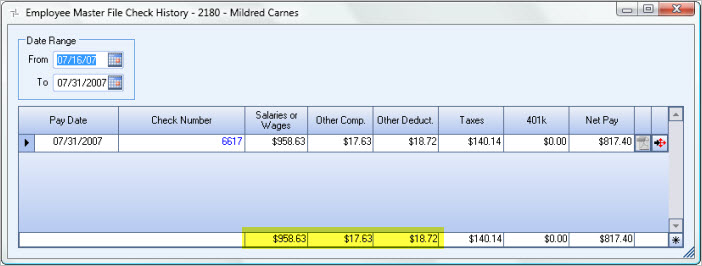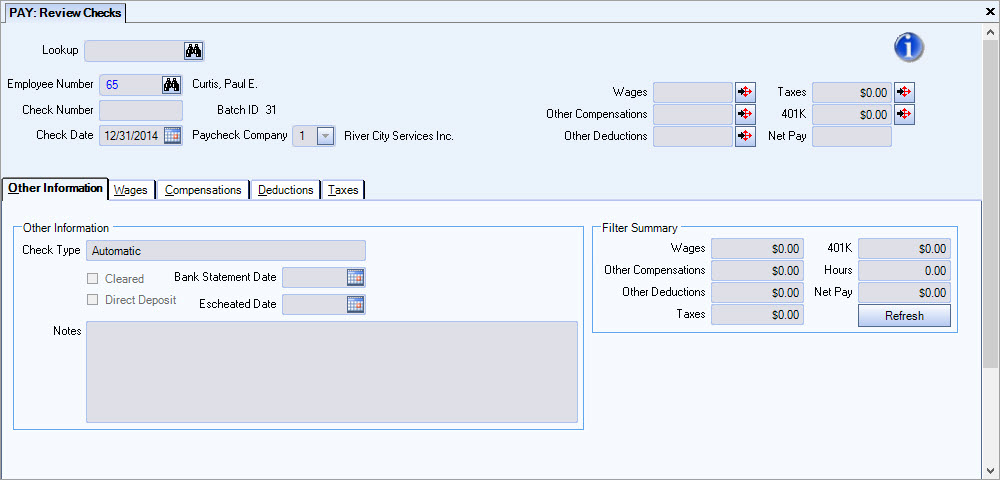Overview
Use the Workers Compensation Report to list all wages, compensations and deductions by state, and workers compensation codes.
The Applicable Earnings Amount does not include Overtime Premium Dollars.
Subcontractor Checks are excluded from this report.

Key Functionality
Type a description to name the report. This description prints above the Report Title.
Available for Clients using the Multi-Company feature. The Default Company Name for Report is populated from the Company Setup screen. The list contains all companies you have permission to access. The default company prints on every page of the report.
If the User has permission to only one company, then just that one company will display in the list. If the User has permissions to more than one company, the list will contain all companies the User has rights to PLUS the default reporting company. For more information see Learning about WinTeam Reports.
Use the Report Format option to choose the level of detail for the report.
Check Dates
Select the Check Dates to include checks based on the Check Dates.
Select All to include all Check Dates.
Select Range to define a range of Check Dates to include. When you select Range, the range fields display. Type the beginning Check Date in the From field and the ending Check Date in the To field.
Classifications
Use the Classifications category to select the Classifications to include on the report.
Select All to include all Classifications.
Select Pick to define specific Classifications for the report. When you select Pick, the Classifications list displays. Select the check box next to each Classification to include on the report.
Employee Types
Use the Employee Types category to select the Employee Types to include.
Select All to include all Employee Types.
Select Pick to define specific Employee Types. When you select Pick, the Employee Types list displays. Select the check box next to each Employee Type to include.
Hours Types
Use the Hours Types category to select the Hours Types to include on the report.
Select All to include all Hours Types.
Select Pick to define specific Hours Types for the report. When you select Pick, the Hours Type list displays. Select the check box next to each Hours Type to include on the report.
Job Types
Use the Job Types category to select the Job Types to include on the report.
Select All to include all Job Types.
Select Pick to define specific Job Types for the report. When you select Pick, the Job Types list displays. Select the check box next to each Job Type to include on the report.
Jobs
Use the Jobs category to select the Jobs to include on the report.
Select All to include all Jobs.
Select Range to define a range of Jobs for the report. When you select Range, the range fields display. Type the beginning Job Name or Number in the From field and the ending Job Name or Number in the To field.
Select Pick to define specific Jobs for the report. When you select Pick, the Jobs list displays. Select the check box next to each Job to include on the report.
Select Create to define your own list of Jobs. When you select Create, a small grid displays to the right. Enter the Job Numbers you want to include in the list, or use the Lookup to locate the Job Numbers.
Select Exclude to identify records that should not be included. When you select Exclude, a small grid displays to the right. Enter the Job Numbers you want to exclude in the list, or use the Lookup to locate the Job Numbers.
Work Dates
The Work Dates category is available if the Include Hours on Report check box is selected. The Work Dates default based on the Check Dates.
Use the Work Dates category to select the Work Dates to include on the report.
Select All to include all Work Dates.
Select Range to define a range of Work Dates for the report. When you select Range, the range fields display. Type the beginning Date in the From field and the ending Date in the To field.
Workers Comp Codes
Use the Workers Comp Codes category to select the Workers Comp Codes to include on the report.
Select All to include all Workers Comp Codes on the report.Select Pick to define specific Workers Comp Codes for the report. When you select Pick, the Workers Comp Code list displays. Select the check box next to each Workers Comp Code to include on the report.
Paycheck Companies
This category is available to users who have more than one company.
Use the Paycheck Companies category to select the Paycheck Companies to include.
Select All to include all Paycheck Companies.
Select Pick to define specific Paycheck Companies. When you select Pick, the Paycheck Companies list displays. Select the check box next to each Paycheck company to include.
Locations
The Locations category is available for Clients using the Multi-Location feature.
Use the Locations category to select the Locations to include on the report.
Select All to include all Locations on the report.
Select Pick to define specific Locations for the report. When you select Pick, the Locations list displays. Select the check box next to each Location to include on the report.
This option is available to users who have more than one company, but is not selected by default. If selected, the default company prints on the Grand Total Page and the Report Criteria page. All other pages print the applicable company name. If not selected, the default company prints on every page of the report.
When this check box is selected, the report will use the Employee's primary job state for Other Compensations and Deductions.
It is recommended that you track Employee primary job history (on PAY: Defaults).
If Track Employee Primary Job History is enabled, the effective dates of the Primary Job history applicable to the check date range entered for the report will determine how the Other Compensations and Deductions will generate on the report.
If Track Employee Primary Job History is not enabled, the Primary Job displayed on the Employee Master File General tab will determine how the Other Compensations and Deductions will generate on the report.
If this check box is selected the Work Dates category is available in the Category/Records area.
Select this check box to print the company logo on the report. It is selected or cleared by default based on the option selected in SYS:Defaults. However, you can modify the setting on each report.
Select this check box to include a list of the report options selected for the report. The Report Criteria page includes any ranges specified and each Category/Record selection made for the report. This check box is cleared selected by default.
Preview
Click the Preview button (or use the shortcut key, ALT + V) to view the report before printing.
Click the Print button (or press ALT + P) to send the report to your default printer.
Export
Click the Export button (or press ALT + X) to export the report to a specified format. Reports may be exported to Adobe Acrobat (PDF), Excel, Comma-Separated Values (CSV), Grid View and E-mail (available for premise-based clients only).
Understanding the Workers Compensation Report
The Workers Compensation Report is grouped by Classification and State. When verifying amounts on the Workers Compensation Report with the Employee Check History, you need to make sure that you look for all states where the employee worked.
Employee Mildred Carnes worked at Jobs where she was classified as a Service Worker in Nebraska and a Service Worker in Iowa. The Workers Compensation Report would have the following information:

If the Regular Rate is $6.00 per hour and the Overtime Rate is $ 9.185, the OT Premium Rate is $3.135. You can verify the calculations from the Employee Master File Check History. The Salaries or Wages column reflects the total of Wages from the Workers Compensation Report.

Click the Detail button  and view the Wages tab for a breakdown of Hours and Rates associated with the check.
and view the Wages tab for a breakdown of Hours and Rates associated with the check.

This particular check has Overtime computed at 3 different rates. To verify the OT Premium Dollars that tie back to the Workers Compensation Report we would first figure the OT Premium Rate, then multiply by the number of hours worked at that rate.
Wages + Taxable Compensations - Non Taxable Deductions - Overtime Premium Dollars = Applicable Earnings
$ 602.96 + 10.80 - 98.96 = $514.80.
Since this employee worked in 2 states, the Employee Check History will reflect a total of these amounts.
The Overtime Premium Dollars are not included in the Applicable Earnings.
The Overtime Premium Rate is calculated as follows:
Overtime Rate - Regular Rate = Overtime Premium Rate
Calculated OT Rate - Pay Rate = OT Premium Rate X OT Hours worked = OT Premium Amount
| Calculated OT Rate | Minus | Pay Rate | OT Premium Rate | Times | OT Hours Worked | OT Premium Amount |
|---|---|---|---|---|---|---|
| $9.00 | minus | $6.00 | $3.00 | X | 25 hours | $75.00 |
| $9.185 | minus | $6.00 | $3.185 | X | 17 hours | $54.145 |
| $12.185 | minus | $9.00 | $3.185 | X | 08 hours | $25.48 |
| $154.625 |
Report Examples
Security
The PAY Report Workers Compensation screen has its own Security Group, PAY Report Workers Compensation.
The PAY Report Workers Compensation screen is part of the PAY Reports All Employees Security Group.
Tip: For more information see Security Groups Overview and Security Groups By Module.

